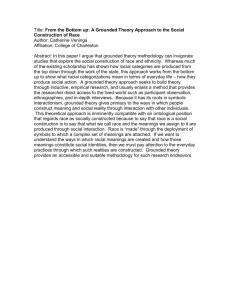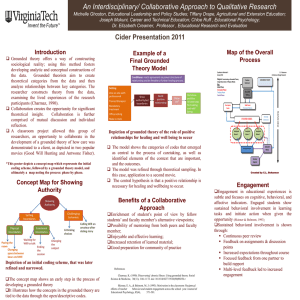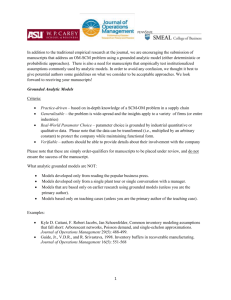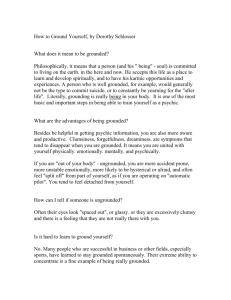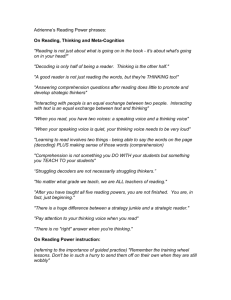The_Grounded_Theory_of_Teaching_2
advertisement
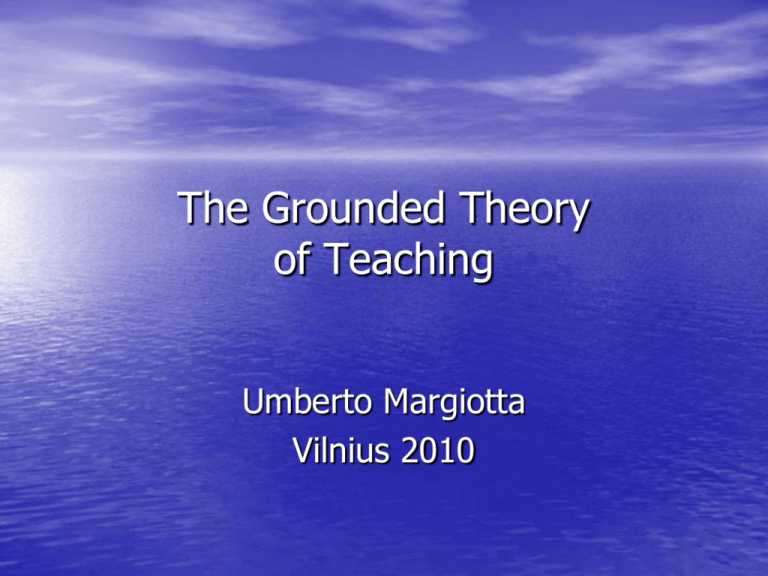
The Grounded Theory of Teaching Umberto Margiotta Vilnius 2010 Wath is happen wen we teaching? We generate knowledge • To teach all students according to today’s • standards, teachers need to understand subject matter deeply and flexibly so they can help students create useful cognitive maps, relate one idea to another, and address misconceptions. Teachers need to see how ideas connect across fields and to everyday life. This kind of understanding provides a foundation for pedagogical content knowledge that enables teachers to generate big ideas The pedagogical content knowledge • In Shulman's theoretical framework • • • (1986,1987), teachers need to master two types of knowledge: (a) content, also known as "deep" knowledge of the subject itself, and (b) knowledge of the curricular development. Content knowledge encompasses what Bruner (as cited in Shulman, 1992) called the "structure of knowledge"–the theories, principles, and concepts of a particular discipline. A model of pedagogical reasoning A P.R. (Shulman 1986, 1987, 1992) comprises a cycle of several activities that a teacher should complete for good teaching: • comprehension, • transformation, • instruction, • evaluation, • reflection, • and new comprehension. Comprehension To teach is to first understand purposes, subject matter structures, and ideas within and outside the discipline. Teachers need to understand what they teach and, when possible, to understand it in several ways. Comprehension of purpose is very important. Purpose’s Comprehension • We engage in teaching to achieve the following educational • • • • • • • purposes: To help students gain literacy To enable students to use and enjoy their learning experiences To enhance students’ responsibility to become caring people To teach students to believe and respect others, to contribute to the well-being of their community To give students the opportunity to learn how to inquire and discover new information To help students develop broader understandings of new information To help students develop the skills and values they will need to function in a free and just society (Shulman, 1992, A. Sen, 2009) Transformation The key to distinguishing the knowledge base of teaching lies at the intersection of content and pedagogy. It’s decisive the teacher’s capacity to transform content knowledge into forms that are pedagogically powerful and yet adaptive to the variety of student abilities and backgrounds. Comprehended ideas must be transformed in some manner if they are to be taught. Transformation of knowledge • Transformations require some combination to govern the • • • • • following processes: Preparation (of the knowledge’s contents), which includes the process of critical interpretation and reorganization Representation of the big ideas in the form of new analogies and metaphors Content selections from among an array of teaching methods and experience models Adaptation of student materials and activities, to promote critic and growth of knowledge in experience and learning styles of students Managing the adaptations to the specific experience of students Instruction Instruction includes many of the most crucial aspects of pedagogy: management, presentations, interactions, group work, discipline, humor, questioning, and discovery and inquiry instruction. Evaluation • Teachers need to think about testing and • • • evaluation as an extension of instruction, not as separate from the formative process. The evaluation process includes checking for reflecting during interactive teaching as well as testing students’ understanding at the end of lessons or units. It also involves evaluating one’s own performance and adjusting outcomes for different circumstances. Reflection • This process includes reviewing, reconstructing, • • • • reenacting, and critically analyzing one’s own teaching abilities and then grouping these reflected explanations into evidence of changes that need to be made to become a better teacher. learning that has occurred–reconstructs, reenacts, and recaptures the events, the emotions, and the accomplishments. All teachers must learn to observe outcomes and determine the reasons for success or failure. Through reflective practices in a group setting, teachers learn to listen carefully to each other, which also gives them insight into their own work (Ornstein et al., 2000). New Comprehension Through acts of teaching that are "reasoned" and "reasonable," the teacher achieves new comprehension of the educational purposes, the subjects taught, the students, and the formative processes themselves. Problem 1 • A current major hypothesis, in arena of • • • educational policies, is that teachers have difficulty teaching certain areas because they themselves lack sufficient understanding about them. Why? What Kind or Amount of Subject Matter Knowledge Do Teachers Need? Master the subject matter knowledge • the content of the subject, • the organization of the content, • and the methods of inquiry used within the subject • are the core aspects of subject matter knowledge. The content of the subject • The content of the subject includes the facts, • • • • • concepts, principles or laws that have been gathered through decades or centuries of inquiry into the subject. Content is usually presumed both to increase in volume and to change in character over time. In history, it evolves with the discovery of new details about events and with the development of new interpretations of events; in science it grows and changes with new research findings as well as new theoretical developments, and in literature it expands with new pieces of literature and it changes with new interpretations of existing pieces. The organization and structure of the content • The organization and structure of the content • • • • refers to the network of relationships among facts and ideas which students of the discipline have developed. Though a subject may contain numerous particular facts or ideas, these are not important in their discrete, isolated forms. Instead, they are rendered important through the patterns of relationships that are constructed among them. It is the patterns, the networks, the interstices among these facts and ideas that form a body of knowledge, such that the significance of any one idea or fact is ascertained by its apparent relation to other ideas and facts. The methods of inquiry • The methods of inquiry include a set of assumptions, • • • rules of evidence, or forms of argument that are or can be employed by those who contribute to the development of the discipline. Some of these rules of practice are tacit (a novelist may "use" rules of sentence structure or story structure routinely, but not be able to describe these rules to someone else). Others are explicit (the historian who challenges another's findings must be able to articulate the rules of evidence he uses in his challenge). Whether tacit or explicit, though, these methods of inquiry provide practitioners in the field with a way to evaluate new ideas, challenge or defend them, interact with one another and with the content. The Questions • First, teachers need to know less about their subjects • • than do others who major in the subjects, for they need to know merely what the curriculum or textbook provides to students?. Second, teachers need to know more than do others who major in the same subject? (teachers also need to know three other aspects of subject matter: its social norms, the relationship between the subject and various social issues, and the utility and relevance of the subject to everyday life). Finally, teachers' knowledge of their subjects must be different ? In wich way? The Answers • Less: teacher is a practicioner • More: teacher is a special researcher • Different: teacher is a reflective practicioner • But, in the knowledge society? Less mastery of subject matter knowledge • Teachers of virtually all grade levels and • • subjects may need to understand fundamental concepts and values within the subjects they teach. Moreover, teachers rarely teach precisely what is in their texts, but instead make numerous decisions of their own about what to teach, in what sequence to teach it, and how much time to devote to it. Finally to make such decisions, teachers need an analytic understanding of the subject, for it cannot be presented as a whole. More mastery of subject matter knowledge • Teaching a subject consists not only of teaching • • its content and methods, but also of teaching about the subject—its cultural, social, and pragmatic relationship to our lives. The culture of a subject is closely related to its method of inquiry, but extends into norms of interpersonal relations. Even if practitioners within a discipline can function without awareness that their field has a separate culture, students may shun certain fields because they feel alienated from them. Different mastery of subject matter knowledge • Teachers' knowledge must differ in its character, • rather than its content, from the knowledge of other baccalaureates. It distinguishes teachers' subject matter knowledge by suggesting that it must be explicit and self-conscious, rather than tacit. The key to pedagogical subject matter knowledge is the word blend. A blend of knowledge is different from a sum of two kinds of knowledge--on one side subject matter and on the other side students. Special researcher & reflective practitioner • The teachers' curricular decisions are closely related to their perception of the subject matter they are teaching. • For some, subject matter means a particular set of skills; for others it means a set of ideas or concepts; for still others it may mean a way of reasoning about certain kinds of problems. Researchs’evidence • Evidence is accumulating to suggest that • • teachers' beliefs can have a substantial impact on their practices Teachers' beliefs about teaching and learning were associated not only with how they taught but also with what their students learned. The possession of a H.E. degree, and even a major in a particular subject, do not assure that a person can explain the structure and organization of subject matter that teach. One way Pedagogy • One method for teaching the scientific method is to • transform it into a list of facts and ideas: to tell students what the scientific method is and how it is done and to provide some illustrations, perhaps describing some famous critical experiments. That is, students are taught how scientists have conducted their work in the past, and the body of facts and ideas they have generated through their efforts. This pedagogy does not allow students to experience of the method themselves; they learn to define the scientific method but not to reason like a scientist, to develop clear arguments or to design critical experiments to test competing ideas. Emulative Pedagogy • Another approach to teaching is to have students re-enact particular critical events, perhaps the same experiments they learned about in the class above, so that students can re-live the experience that the original scientists experienced. • This method is common in science education, where "lab" classes often accompany lecture classes, so that students can try experiments for themselves. • Through this pedagogy, students learn how to conduct experiments and they see the connection between particular experiments and particular content. • But these experiments are emulations of experiments already done, whose outcomes are already known, so that students are still not learning to reason as scientists do, but instead are learning the procedures of particular, known experiments. Critical Pedagogy • A third way to teach the scientific method is to define the components of the scientific method--things like observation, measurement, hypothesis generation, and so forth, and give students practice in these components. • Unlike the first pedagogy, which emphasizes the relationship between scientific reasoning and the accumulation of new content, and unlike the second, which emphasizes particular procedures associated with particular experiments, this pedagogy emphasizes generic reasoning strategies. • Students learn a particular way of reasoning, and perhaps some rules of evidence, but do not learn the way in which arguments are justified or challenged, nor the content that has derived from using these procedures in the past. Generative Pedagogy • Finally, one could teach the scientific method by • • transforming the classroom into a miniature scientific community in which students argue about particular phenomena and then conduct experiments to ascertain which of their hypotheses makes most sense. Through this pedagogy, students develop their own body of scientific content not only by applying the techniques of the scientific method but by engaging in the reasoning and debate that are part of the scientific community. But although students learn more about the culture and norms of science, they may learn less about the particular content that scientists have learned through their application of the scientific method. 2. What is Grounded Theory? Introductory Contestualisation The big Ideas of Grounded Theory • Orienting theory generated from experience vs Naive • • • • • Baconian Induction Abduction vs. Induction Data vs. Phenomena Comparative Problem-Centered Method vs intuictionist learning: By (1) comparing incidents applicable to each category of analysis, (2) integrating categories and their properties, (3) delimiting the theory, and (4) writing the theory. Theory Generation vs. Theory Appraisal Grounded theory can help you • Gather rich data through guiding your data collection • Get started in early data analysis • Use flexible guidelines for managing your research • Keep focusing your analysis to make it more original and useful What is grounded theory? A systematic method of conducting research that: • Begins with an observative approach • Involves engaging in simultaneous data collection and analysis • Consists of several flexible guidelines • Emphasizes constructing the analysis • Aims to construct middle-range theories What is grounded theory? (cont.) • A method that goes beyond induction - Its strategies lead to making conjectures and hypotheses and to checking them -Therefore, the researcher engages in abductive reasoning as inquiry proceeds. What does grounded theory help you to accomplish? This method: • Enables you to study processes • Helps you explicate what is happening in your field setting • Keeps you focused on your data and emerging analysis • Supports you in developing an original theoretical analysis How do grounded theorists conduct research? We engage in: • Making systematic comparisons throughout inquiry • Interacting with our data, codes, and categories • Doing analytic writing from the start— memo-writing • Making early links between the empirical world and theoretical ideas—and checking them—theoretical sampling Wouldn’t it be helpful to have a few questions to guide your research? Grounded theory gives you general questions—and points the way for you to develop further questions specific to your research problem and emerging analysis Grounded theory helps you to keep your research • Manageable • Efficient • Exciting! Which questions do grounded theorists use when coding data? • What is happening? (Glaser, 1978) • “What is this data a study of?” (Glaser, 1978, • • • p. 57; Glaser and Strauss, 1967) What theoretical category does this datum indicate? (Glaser, 1978) What does the data suggest? Pronounce? From whose point of view? Wouldn’t it be helpful to have guidelines for coding qualitative data? • Use line-by-line coding as an initial tool for opening up the data • Ask what is happening in each bit of data • Compare data with data 1. Statement with statement 2. Story with story 3. Incident with incident • Then compare code with code Coding for what is happening So part of it has been good because I can see that I'm not the only one that has good days and bad days, everybody does. They might not be physical, as much as psychological, but everybody has kind of good days and bad days, as moods and things too. Identifying a positive Recognizing other people’s good and bad days Qualifying their good and bad days Viewing good and bad days as universal Comparing Statements: Umberto Taking a broader view beyond self So part of it has been good because I can see that I'm not the only one that has good days and bad days, everybody does. Seeing beyond self They might not be physical, as much as psychological, but everybody has kind of good days and bad days, as moods and things too Discerning the content of good and bad days Comparing statements: Margaret dealing with her illness on a bad day and her mother with Alzheimer’s—Being caught in chaos And if I’m trying to get dinner ready and I’m already feeling bad, she’s in front of the refrigerator. Then she goes to put her hand on the stove and I got the fire on. And then she’s in front of the microwave and then she’s in front of the silverware drawer. And-and if I send her out she gets mad at me. That’s when I have really a really bad time. Making a bad day worse Escalating chaos See also, Arthur Frank (1995): “The Chaos Narrative Comparing responses to bad days: Marco— Dealing with bad days We’re [a friend who has multiple sclerosis] kind of like mutual supporters for each other. And when she has her bad days or when we particularly feel “poor me,” you know, “Get off your butt!” You know, we can be really pushy to each other and understand it. Reciprocal supporting Having bad days Disallowing self-pity Issuing reciprocal orders Taking the criticism Realizing that once bad days have become good days—John What used to be bad days [laughing] now are good days …but the quality of things, I think, is declining, you know, from , say a couple of years ago when I didn’t think about it that much. And there would be isolated days when I had a lot of congestion and things like that. But that’s all. Shifting criteria of good and bad days Defining declining health Comparing past and present What is constructivist grounded theory? It is a contemporary revision of Glaser and Strauss’s (1967; Glaser 1978) classic grounded theory that: • Assumes a relativist approach • Acknowledges multiple standpoints and realities of both the grounded theorist and the research participants • Takes a reflexive stance toward our actions, situations, and participants in the field setting, and constructions of them in our analyses. How does constructivist grounded theory advance data collection? It fosters building explicit “what” and “how” questions into the data collection She said…,But, fortunately, I had the experience of at some point surrendering, you know. I asked, What does that mean to you, surrendering? She said, It means that I don't have, I can't control it and to look at what it has to teach me. Just, you know, let it tell me what it needs to tell me. You know, that willingness and that acceptance. Data collection in constructivist grounded theory And you don't always get, you know, I don't always get that right away because here I could have had a lot of "control" over my life, and then I didn't have control anymore, and so it didn't come instantly, but I was willing to surrender and to look at what was going on. But it did come, it did happen. And I'm always much more at peace after I'm able to do that anyway. Where Does Constructivist GT Take Us? This approach leads us to • Assume that what we take as “real” is problematic—and that our analyses are interpretive • Look for multiple definitions of reality • Pay close attention to language—and action • Examine how experience is constituted and structures are enacted In sum, what is grounded theory? • An abductive, comparative, and interactive approach to inquiry that offers several open-ended strategies for conducting emergent inquiry. Lakatos’s Picture of Science • The typical unit of science is not an isolated hypothesis, • but rather a research programme, consisting in a hard core (theory), protective belt (auxiliary assumptions) and a heuristic. A heuristic is a "powerful problem solving machinery, which with the help of sophisticated mathematical techniques, digests anomalies and events turns them into positive evidence. For instance, if a planet does not move exactly as it should, the Newtonian scientist checks his conjectures concerning atmospheric refraction, concerning propagation of light in magnetic storms, and hundreds of other conjectures that are all part of the programme. He may even invent a hitherto unknown planet and calculate its position, mass and velocity in order to explain the anomaly." (Lakatos, 1977, p. 5) The Lakatos Methodology in education • As in all researches, all scientific curriculum research programs may • • • • be characterized by their ‘hard core’. The negative heuristic of the program forbids us to direct the modus tollens at this ‘hard core’. Instead, we must use our ingenuity to articulate or even invent auxiliary hypotheses, which form a protective belt around this core, and we must redirect the modus tollens to these. It is this protective belt of auxiliary hypotheses which has to bear the brunt of tests and get adjusted and re-adjusted, or even completely replaced, to defend the thus-hardened core. A research program is successful if it leads to a progressive problem shift, unsuccessful if it leads to a degenerating problem shift. The final question Could we teach by contents or by metodology program’s research?
